On paper, enterprise innovation management software is meant to crowdsource ideas and push them into assessment, validation, and, finally, implementation.
However, in practice, a problem we see with many innovation management tools is that they put too much emphasis on collecting ideas and idea management and not enough focus on actually moving these ideas forward into implementation. This creates two problems:
Companies collect ideas from employees, and these ideas sit in a spreadsheet where nobody implements them. Innovation managers don't have the bandwidth to assess all ideas and move them forward.
Innovation managers choose the best ideas and send them to the appropriate department. Department leaders then take the ideas offline and work on them without insight or collaboration from anyone else in the company. This kills innovation because department leaders aren’t utilizing the creative power of their entire workforce to develop ideas.
To avoid those issues, we’ve learned there are three factors to consider when choosing innovation management software:
Entire lifecycle: Innovation management software should help companies manage the whole innovation process, not just idea collection.
Configurable assessment workflows: Ideas in different categories naturally require different implementation steps. For example, implementing a new product idea vastly differs from implementing a small continuous improvement or a new business model idea. Innovation management software should provide different workflows for implementing various types of ideas.
Collaboration: You should utilize the creative brain power of your entire organization to develop ideas. Everyone should be able to see, rate, and provide feedback on ideas — regardless of where they are in their life cycle.
Below, we’ll review five of the most popular innovation management software options for enterprise organizations in the context of the above factors to consider, starting with a deep dive into our platform, InnovationCast.
If you’d like to learn more about how InnovationCast can create a culture of innovation within your enterprise company, schedule a free demo.
1. InnovationCast: Customizable, Scalable Enterprise Solution for Turning Ideas into Implementable Innovations
We’ll discuss InnovationCast via four components:
How we collect ideas correctly
How we move ideas forward into implementation
How we test ambitious ideas to see if they will work
Additional tools that promote innovation inside enterprise companies
Idea Collection and Feedback
As we alluded to above, all enterprise innovation management software have some component of idea collection. However, in our decades of experience consulting with enterprise companies on their innovation processes, the details of how ideas are collected matter.
Specifically, most companies use what we like to call a “digital suggestion box,” where there is an always open call for employees to submit ideas to a web page or email address. These submissions typically aren’t viewed by anyone other than the innovation managers.
This creates two problems:
Since employees aren’t informed about the initiatives the innovation department is currently focused on, the problems it’s trying to solve, and the ideas that have been unsuccessfully implemented in the past, they tend to submit ideas that aren’t tied to organizational goals. You might receive a relevant idea every now and again, but it’ll be scarce.
Employees can submit ideas at any time, so there’s no sense of urgency to get them submitted.
This is why we built an idea collection feature we call Challenges into InnovationCast.
Challenges Allow You to Collect Relevant Ideas
Challenges are time-bound calls for ideas on specific topics. Innovation managers and stakeholders can create a challenge around a problem the company is facing or an initiative they’ve been tasked with. They can then use images, videos, and articles to provide employees with the context needed to understand the problem, what’s been tried before, and the details of what kind of ideas they need.

This solves the three problems mentioned above:
You receive ideas specific to the company's or the innovation department's current priorities and initiatives.
You can frame the assumptions, and use photos and videos to provide employees with context around your problem, as well as ask questions to force them to think through important aspects of their ideas, which results in higher-quality ideas.
Each challenge is open only for a finite amount of time. We’ve found that the deadline creates a sense of urgency, which encourages more idea submissions.
We also have an “Always On” feature where you can collect more general, less time-sensitive ideas. But don’t mistake this for a digital suggestion box. Employees still have to state which topic their idea is related to and provide an explanation of why they are submitting it and how it can benefit the organization. We’ve found that this ultimately improves the quality of ideas.
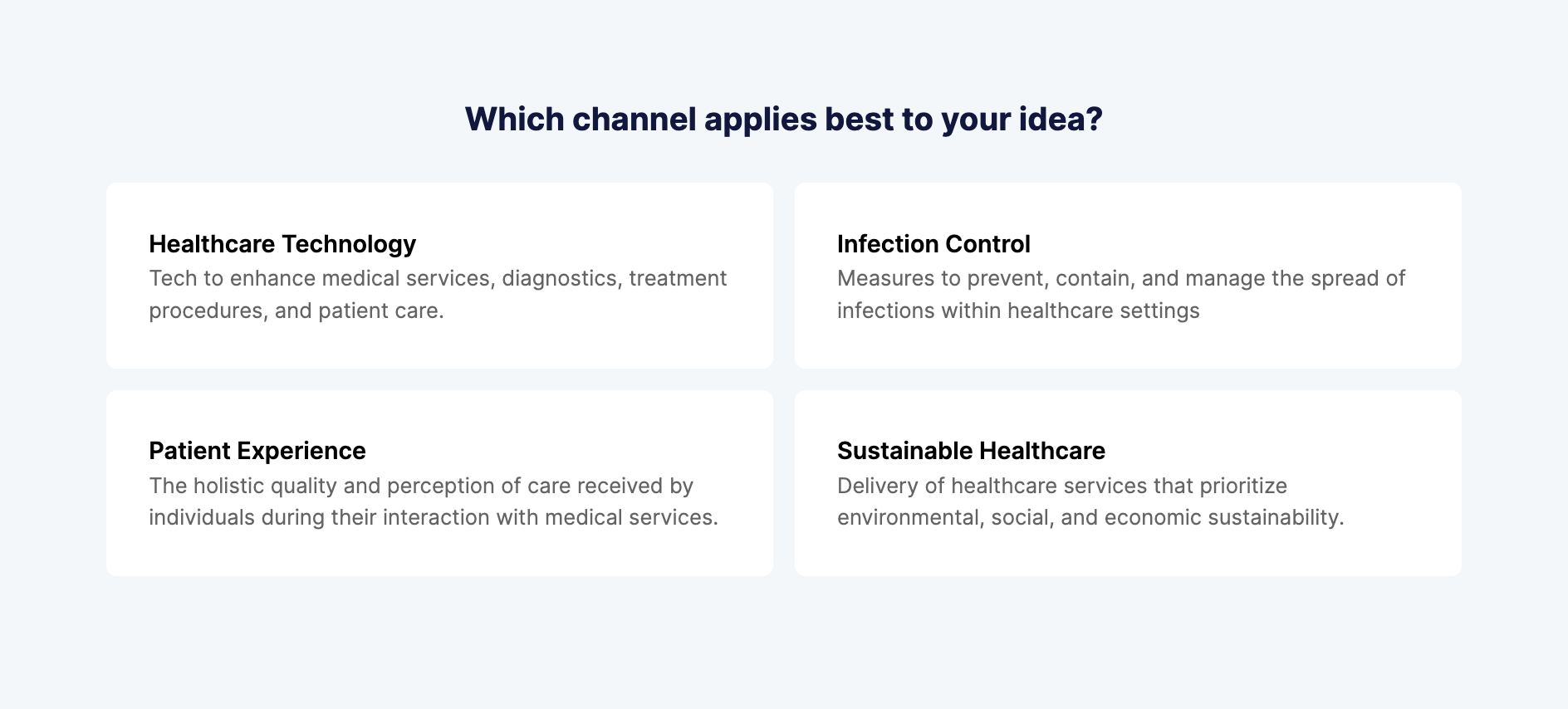
Everyone Inside Your Enterprise Company Can View New Ideas
Another problem we intended to fix when creating InnovationCast is the lack of collaboration tools and feedback after an idea is submitted. In most innovation workflows, submitted ideas are only viewable by a select few (typically the innovation managers). This limits the quantity and quality of feedback that ideas can receive because there are only so many innovation managers with limited time, and they don’t have subject-matter expertise on all topics.
In addition, this kind of “closed door’ idea submission reduces engagement and involvement in innovation efforts from the wider company. Employees have no way of following what ideas were submitted, seeing interesting ideas develop, giving their input, and more. As a result, it’s hard to build a culture of innovation.
We designed collaboration features into InnovationCast to help fix these issues.
When an employee submits an idea, everyone else — not just the innovation managers — can see it on their activity feed. Fellow employees can leave suggestions and point out weaknesses in ideas that their colleagues proposed, encouraging original contributors to continuously edit and improve their ideas.

This allows you as an organization to develop good ideas to their full potential while quickly filtering out flawed ideas.
What’s more, employees can follow certain challenges and ideas and get notified about new edits and comments, prompting continuous discussion and, importantly, engagement from employees even if they don’t have original ideas to submit themselves.
Everyone Can Vote on Ideas to Provide Feedback
Another way you can utilize the creative might of your entire organization to develop ideas is with our feedback voting features.
When an employee submits a new idea, other employees can vote on these ideas by saying if it “Looks great,” “Needs work,” or whether they are “Undecided.”
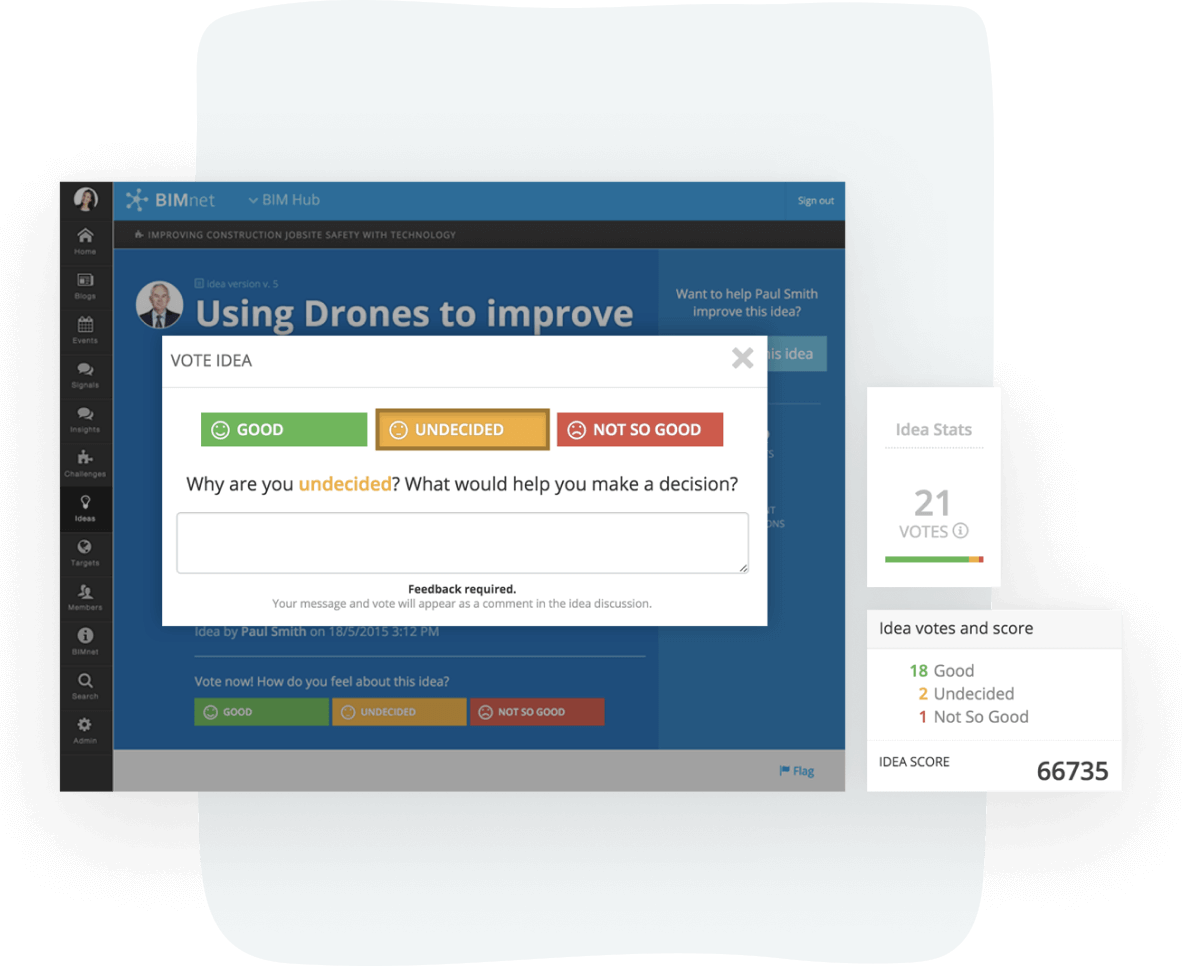
But even here, we prompt employees to give feedback on why they said an idea “Looks Great” or “Needs Work” so they aren’t mindlessly voting on ideas. This encourages constructive criticism and brainstorming during the idea collection phase.
To promote collaboration within your innovation network and reward employees who give the most constructive feedback, the original idea contributor can mark feedback given by their colleagues as a “significant contribution.” This gives credit to employees who played an important part in improving an idea and adds a gamification component to innovation management, which increases employee engagement.
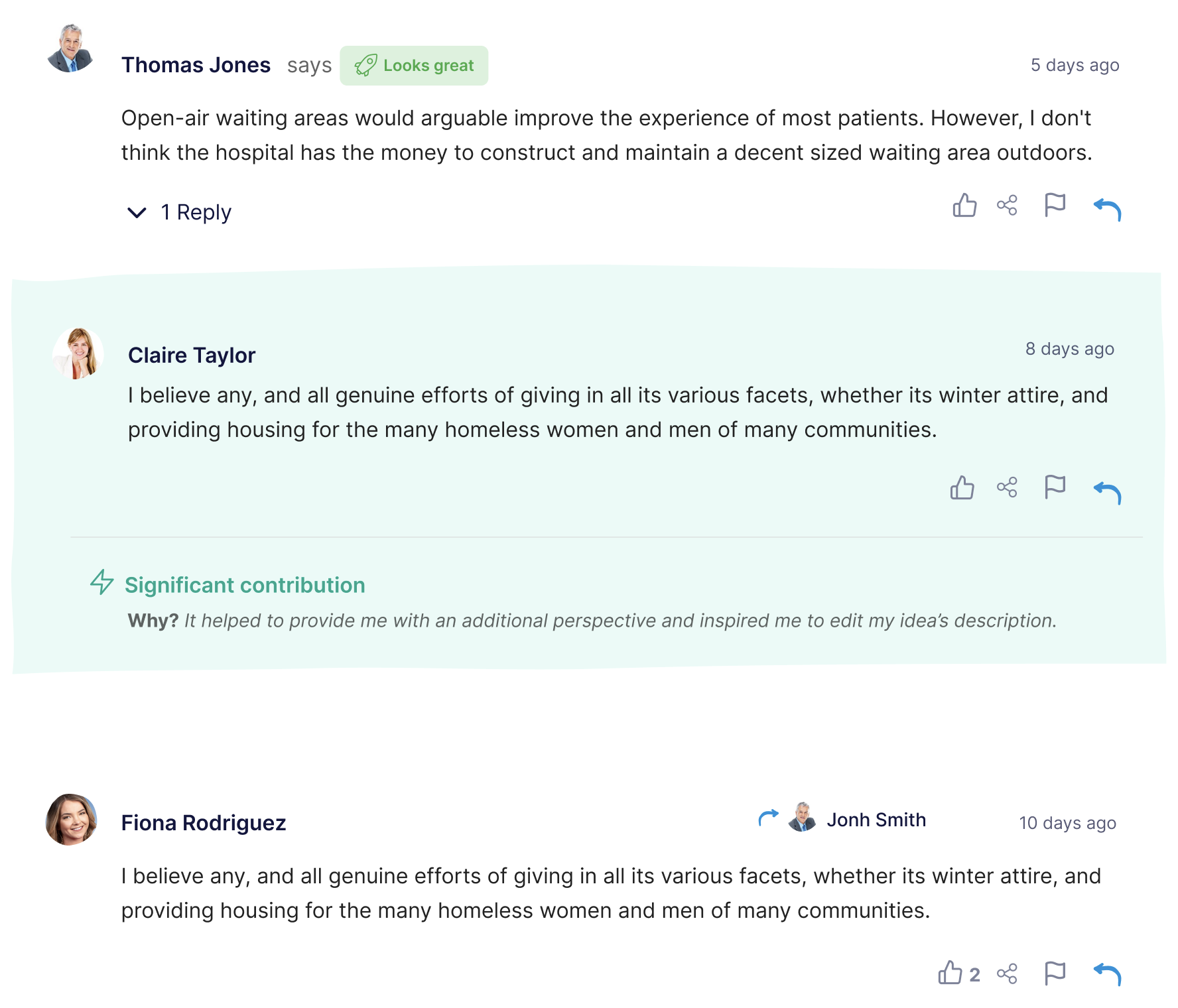
Idea Assessment Workflows
As we mentioned in the introduction, if your organization doesn’t have the tools and processes to assess, test, and implement ideas after the collection phase, they will typically just sit in a spreadsheet collecting dust.
A key aspect of this is that ideas in different categories will have different assessment workflows. For example, a new product idea will have a different workflow than an HR-related idea – that’s natural.
However, a problem we’ve seen with some innovation management software is that they only support a single idea assessment workflow. The users set up what they want their assessment workflow to be, and all ideas in the software go through that workflow. We’ve noticed that when this happens if an organization is developing an idea that doesn't fit their software's assessment workflow, they have to take it offline to begin working on it, killing collaboration and innovation.
To avoid this, we let organizations build as many custom idea assessment workflows as they need. This way, they can move any idea into implementation, whether it’s a business process idea or a new product idea, through a workflow that makes sense.
Our workflow templates support various types of innovations: product innovations, technological innovations, business model innovations, and operational innovations.
Think of these idea assessment workflows as starting points. They walk you through everything you need to do during each stage of the innovation management process to improve and implement your idea. This includes who you should notify when you collect an idea, who needs to manage each step, and when to conduct financial risk analysis and market research.
So, for instance, if you're introducing a new HR process, you could use our HR assessment workflow:
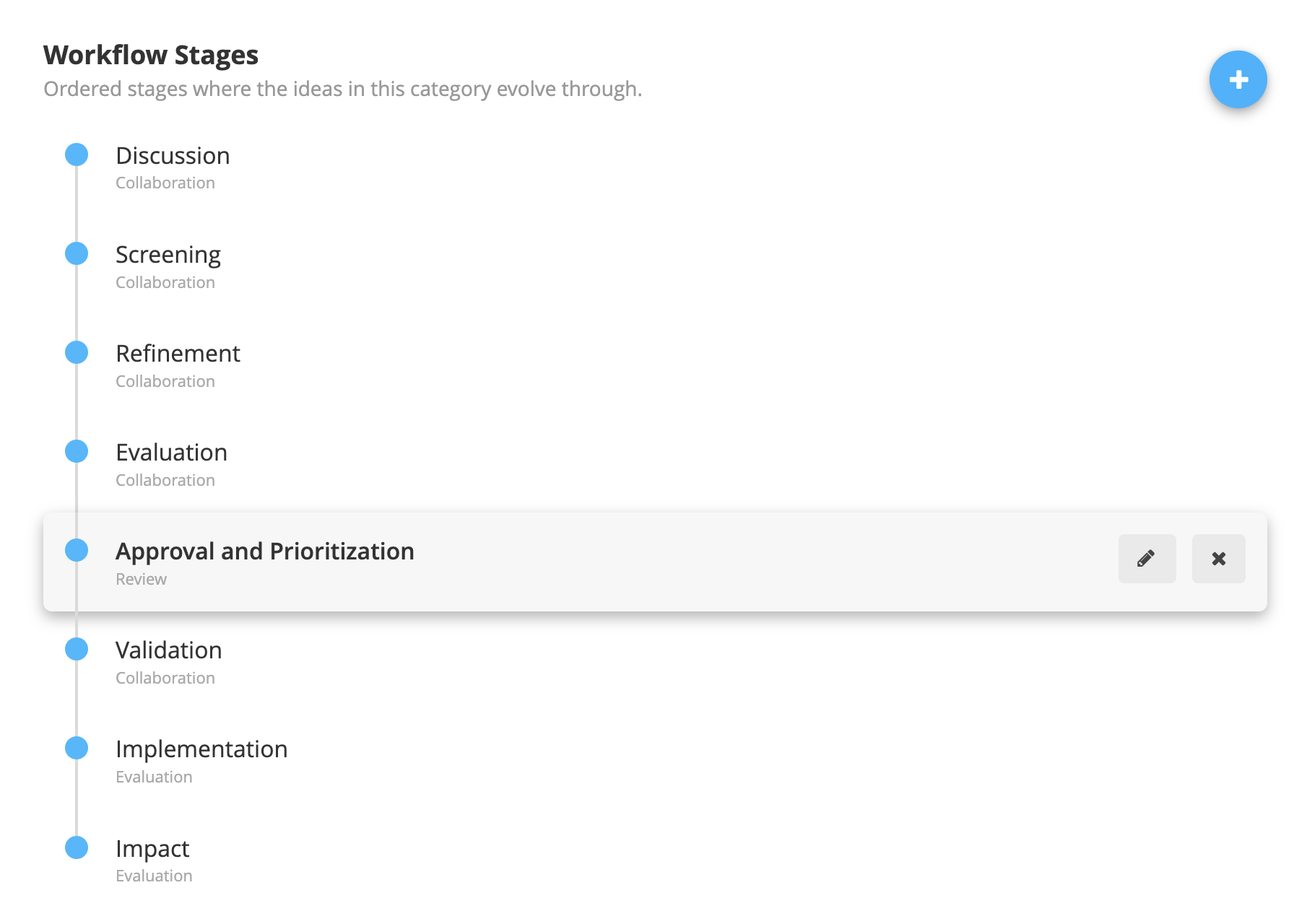
Here, you can have HR leaders discuss ideas and move them to screening. If ideas are good enough to be assessed, they can move them to evaluation, and if changes need to be made, they can move them back to refinement and, ultimately, approval and implementation.
This workflow is completely different from a new product idea workflow, for example, you'll need to do a consumer proposition, build a business case, test any assumptions, and develop and launch the product.

But these idea workflows aren't set in stone. We recommend continuously tweaking them to optimize the innovation process. With InnovationCast, this is really easy because you can rearrange your workflow or add new steps by dragging and dropping a couple of blocks; no coding is required.
Detailed Workflow Stages
In addition to making it easy for you to customize your idea assessment workflows, InnovationCast also allows you to configure each workflow stage so that you can change things like:
Who needs to assess the idea, and what criteria must be used
Which teams need to sketch the MVP, run financial risk analysis, and gather customer feedback
What files need to be submitted
What experiments need to be run
For example, if your company is collecting ideas for a new product, you can establish criteria to assess ideas at the collection stage, run a financial risk analysis to evaluate how likely the idea is to succeed, and debate on which idea to take forward.
When you move the best product idea to the MVP sketch phase, you can set the workflow to automatically notify the software development team that they need to sketch an MVP. When the MVP sketch is complete, stakeholders will be notified so they can move to the customer feedback stage.
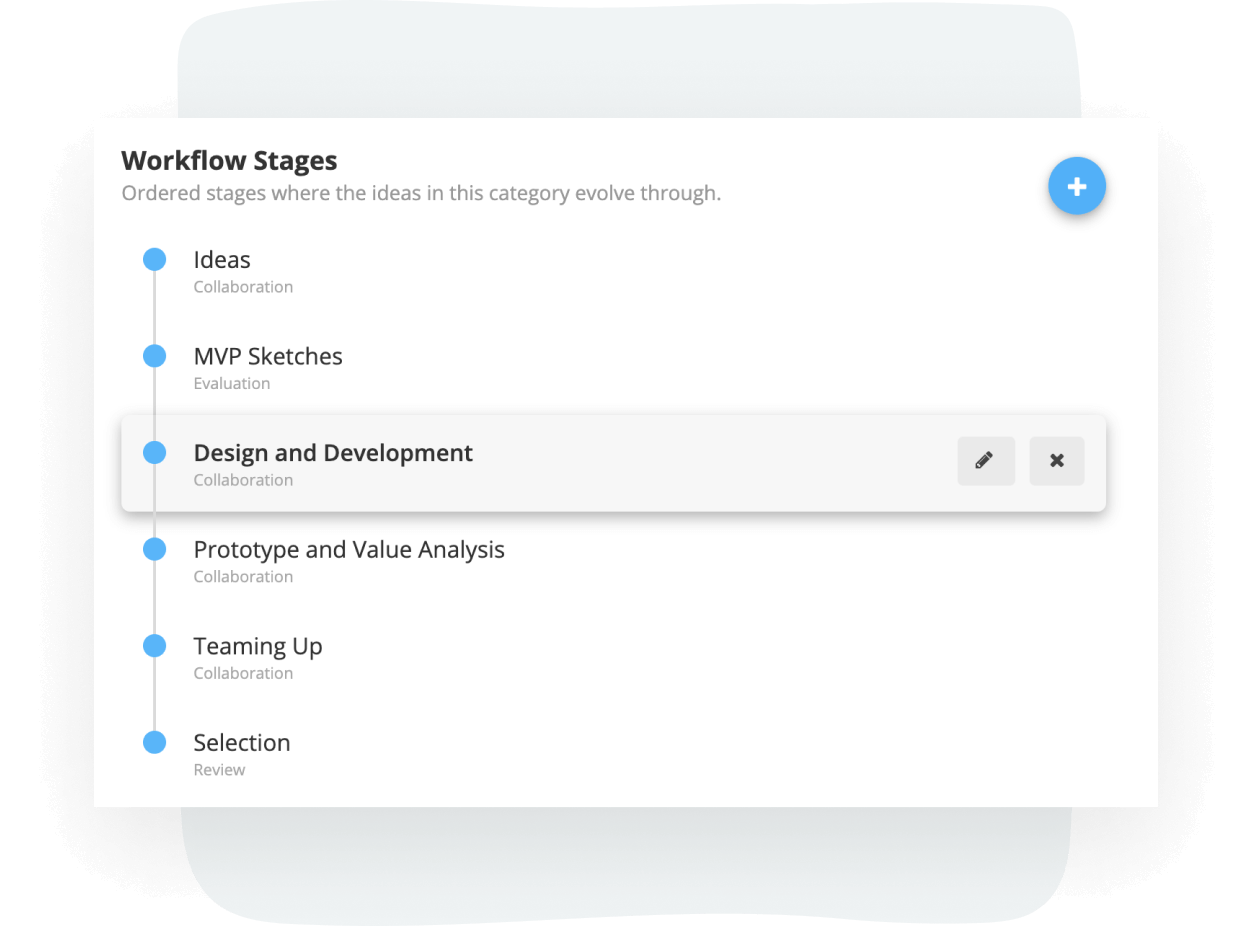
Continuing with this example, when the MVP goes to the customer feedback stage, stakeholders can automatically notify the customer support team, letting them know they need to book calls with customers and get their thoughts on the new MVP.
This depth allows you to manage the entire innovation process inside InnovationCast. Employees inside your organization get notified when they need to sketch an MVP or conduct financial risk analysis, for example. So everyone knows exactly what they need to do during each stage, and there are deadlines to keep your project on track.
Assumptions and Experiments
Teams can use our Experiments board for ambitious ideas where there's a lot of uncertainty and you aren't sure whether you'll be able to bring them to life.
Our experiment board works like a project manager. You can assign employees to tasks (experiments), and the outcomes of these experiments will allow you to validate whether an idea will live up to your expectations.
We'll first ask about any assumptions you have about an idea: what needs to be true for the idea to work. For example, you might have assumptions about how a new process can reduce customer churn or about the value a new mobile app will generate for your customer base.
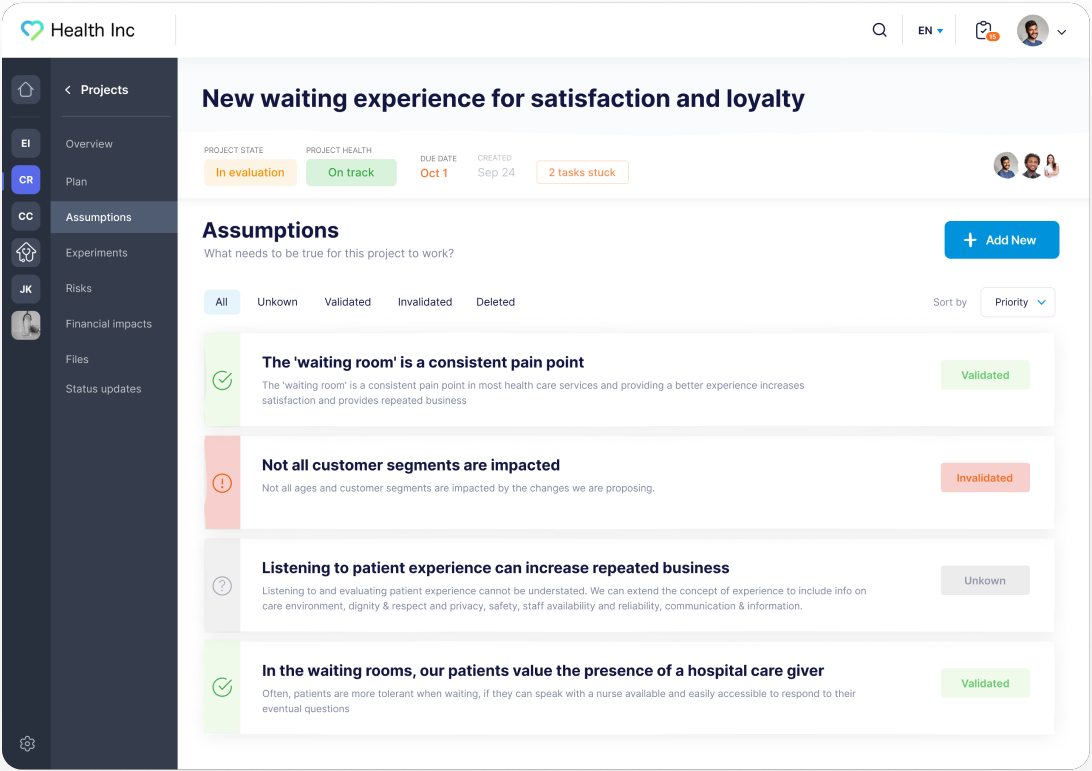
With these assumptions in place, you can design experiments to test them: customer interviews, prototypes, landing pages, etc. For example, if you think hiring a nurse to work in your hospital's waiting room will reduce patient churn, you can hire a nurse, test this for a month or two, and track the results inside your experiment dashboard.
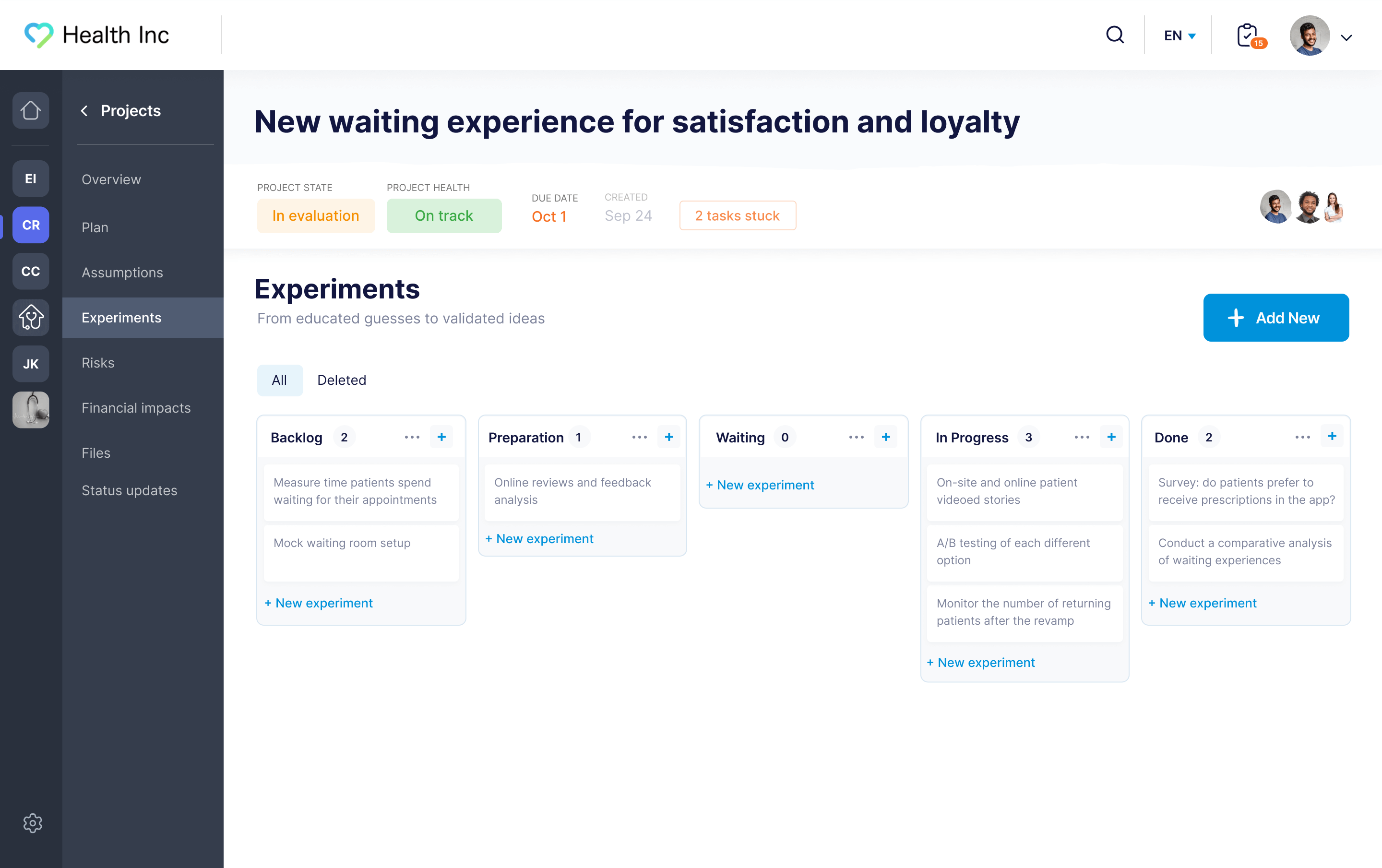
This way, you can make small bets on several ideas without blowing your entire budget. The key is not to invest too much and too soon. When you see an idea that isn't really profitable, you can cut it off, or if an idea exceeds expectations, you can dedicate more budget to it.
Read more: Best Practices to Evaluate Innovation Ideas
Project and Portfolio Management
Lastly, teams can use our native project management tools to plan implementation tasks for ideas they’ve tested and validated and are ready for launch. Our system works like familiar project management dashboards — where you plan out tasks (with all the details), add due dates, assign team members, and then track progress.
Within our dashboard, teams can see all in-progress projects (with real-time status) and past projects. This allows you to manage the innovation portfolio — you can keep a historical record of all innovation activities, track past projects' outcomes and KPIs, and use past projects' lessons to promote success in future initiatives.
Additional Tools That Fuel Innovation Inside Your Enterprise Company
These are some additional features we built into InnovationCast to promote innovation and include even more employees in the innovation initiatives beyond the collection, iteration, and implementation of ideas:
Scouting and signals
Radars
Employee badges and rewards
Easy onboarding
Scouting and Signals
Signals is a collaborative feature that allows employees and stakeholders to share relevant information, such as news articles, videos, and research papers, with everyone else to help achieve company-wide goals. This creates yet another way for employees to participate in the innovation process even if they don’t have an idea to submit themselves.
Everyone can see these resources when they scroll through the timeline on their dashboard and can comment on them, which can spur discussion and ultimately fuel idea generation within your organization.

It also solves the problem many enterprise companies face: It takes several months for employees to send concepts, key news, or issues to upper management. Employees might see that a competitor launched a new feature and realize their company needs to do something similar. But it takes forever for the idea to go from front-line employees to management, preventing the company from acting quickly.
Signals allow the CEO and department leaders to immediately see the resources that interns and receptionists share, ensuring minimal communication delays.
Radars
We also have a feature called Radars, where users can visualize all the signals that others have submitted for a given area of interest. For example, if you’re tracking the features that your competition is releasing, you can view them by medium-priority, high-priority, and disruptive features.

Employee Badges and Rewards
A core value of ours is to recognize employees and show them the impact of their ideas, comments, and participation. Employees drive innovation within enterprise companies; without them, there is no innovation project.
This is why employee badges and rewards are such an essential feature. It incentivizes employees to submit ideas and participate in discussions or give feedback, resulting in a much stronger innovation community versus one where the only way to participate is to have your own idea to submit.
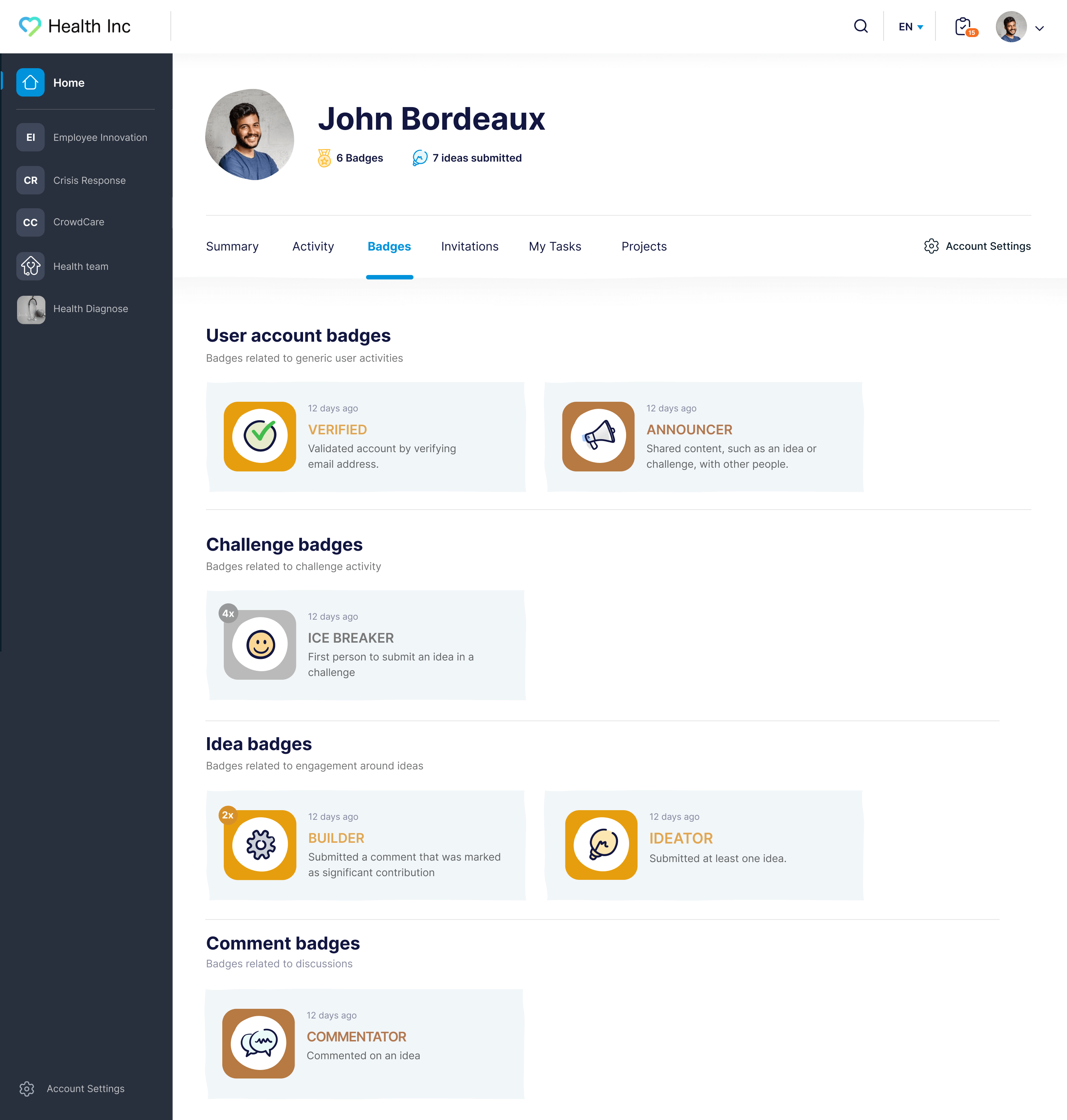
Easy Onboarding
A final fundamental problem we’ve seen enterprise companies face is getting everyone within the organization onboarded and participating when they roll out the software.
We’ve seen many enterprise companies introduce new innovation software into their workflow, but nobody uses it because they are so accustomed to Jira, Asana, Miro, etc.
This is why we provide InnovationCast clients with hundreds of email templates they can use to onboard employees, prompt them to suggest ideas, and contribute to existing discussions. This ensures your innovation projects don’t die before they get off the ground.
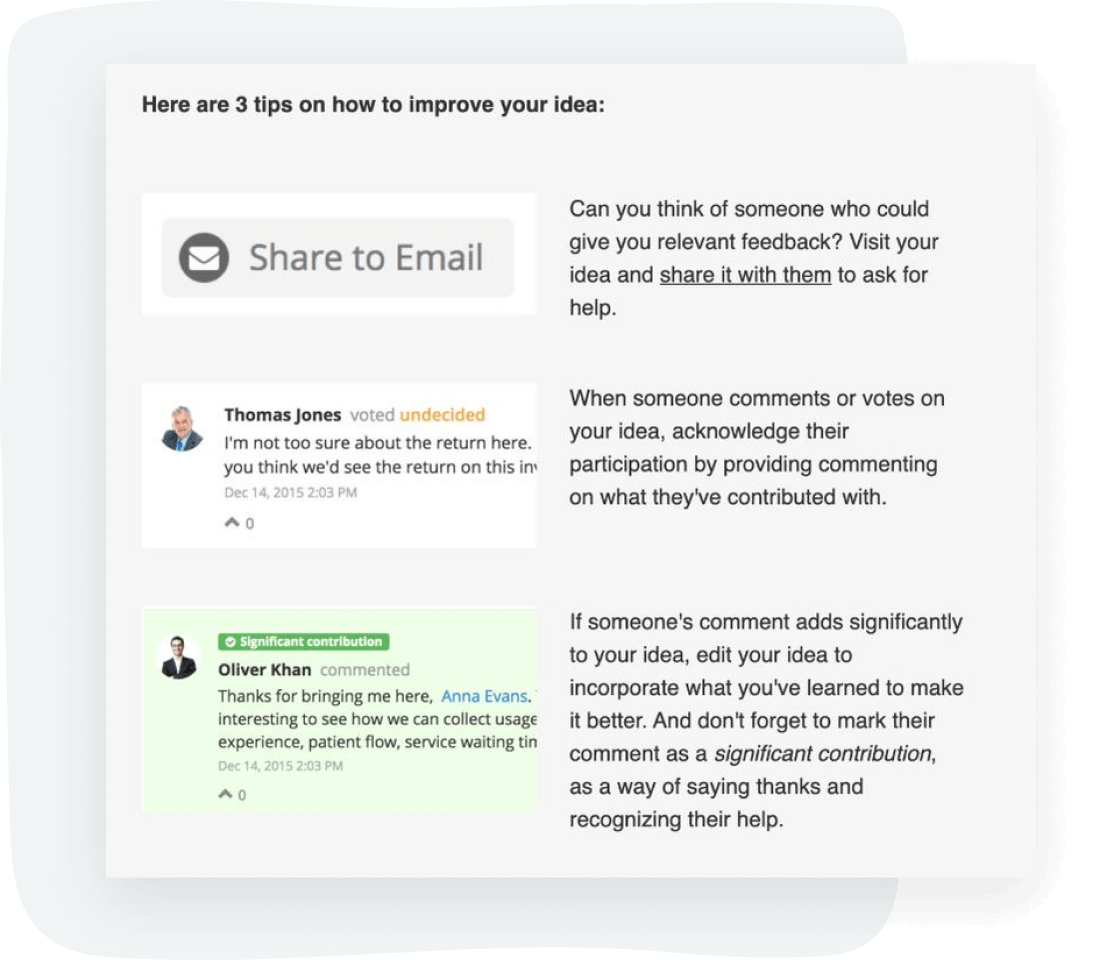
Read more: How to Encourage Innovation in the Workplace
Case Study: How InnovationCast Helped DHL Establish a Culture of Innovation
To give you an idea of how we fueled innovation inside other enterprise companies, we wanted to talk about a client of ours, DHL, and how we launched their employee innovation program in just one month.
DHL is a logistics, shipping, and transportation company that employs over 500,000 employees and operates in hundreds of countries worldwide.
Before using InnovationCast, they already had an established innovation team with good processes, but they struggled to involve their IT team of 5,000 remote professionals in company-wide innovation efforts.
So, in partnership with InnovationCast, DHL created IdeaHub, an innovation platform where all 500,000+ employees and remote IT professionals could collaborate and generate ideas to solve company-wide challenges.
DHL used our workflows to support various innovations, from new product developments to business idea innovations and HR innovations. These workflows included steps to collect relevant ideas, gather feedback, improve them, test them, and prepare them for implementation.
DHL launched IdeaHub in all its countries, which resulted in a 67% increase in submitted ideas and a 14% increase in implemented ideas.

Book a Free InnovationCast Demo
If you’d like to promote a culture of innovation within your enterprise company using the features mentioned above, book a free demo here.
2. HYPE Enterprise
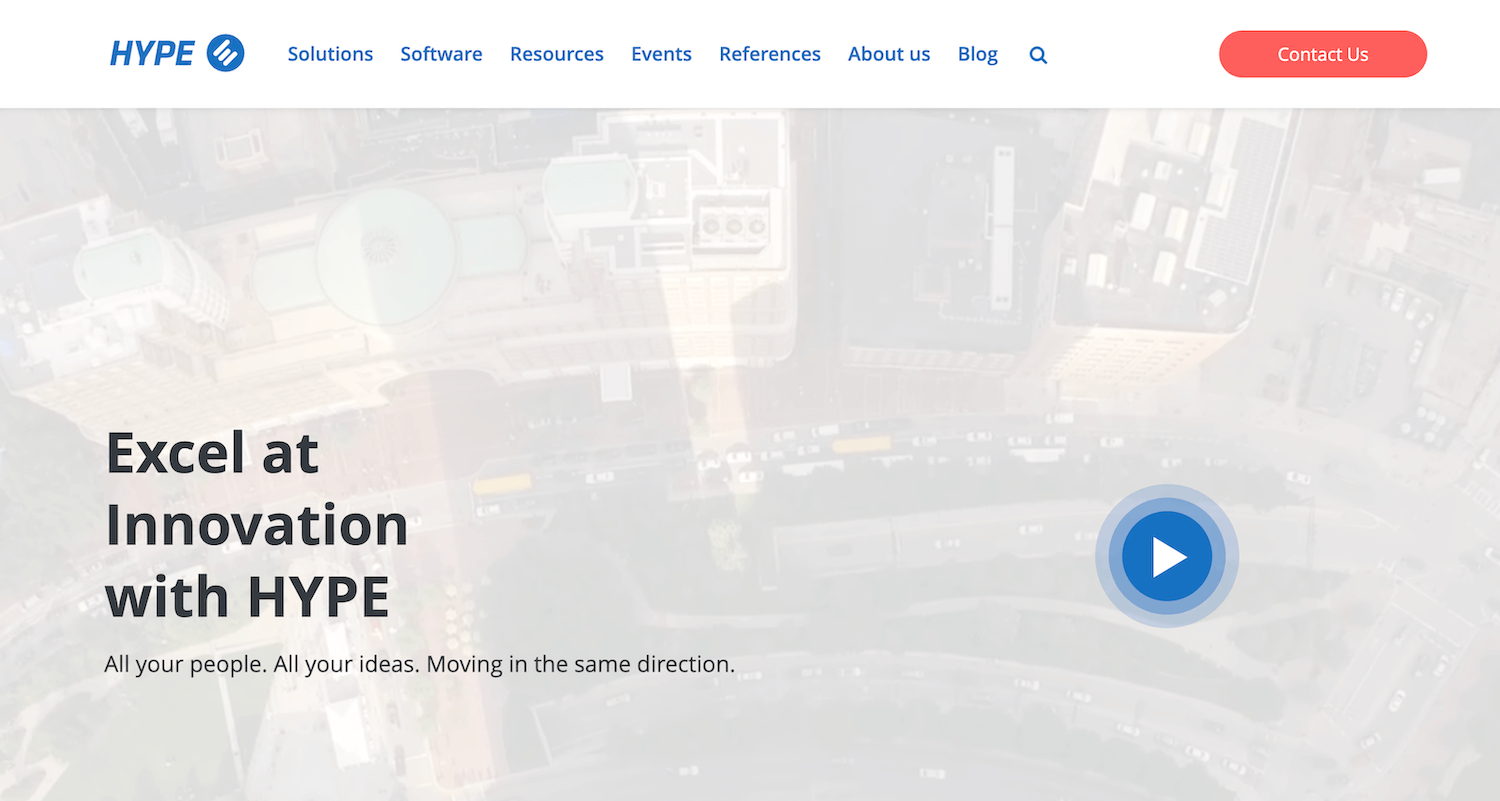
HYPE Innovation offers innovation software and consulting to teams of all sizes — they also offer idea management software, Viima.
When you book a call with them, they’ll start the onboarding process by understanding the challenges your organization is facing, what type of ideas you’re trying to collect, and what you want to do with these ideas.
From here, they’ll create a workflow to support your company’s innovation activities and configure other parts of the platform according to your requirements.
HYPE Innovation’s features can be split up into four modules:
Strategy: Where you can create a roadmap from collecting, testing, and implementing ideas.
Ideation: Where you can collect ideas from employees inside your organization.
Partnering: Where everyone works together to spot idea weaknesses and areas for improvement.
Projects: Where you create workflows to push ideas into implementation and manage your innovation portfolio.
Pricing
HYPE markets its innovation management platform and consulting services as separate solutions, but it doesn’t disclose pricing for either on the site. If you’re interested in working with HYPE, you’ll have to contact them for a custom quote.
3. Wazoku
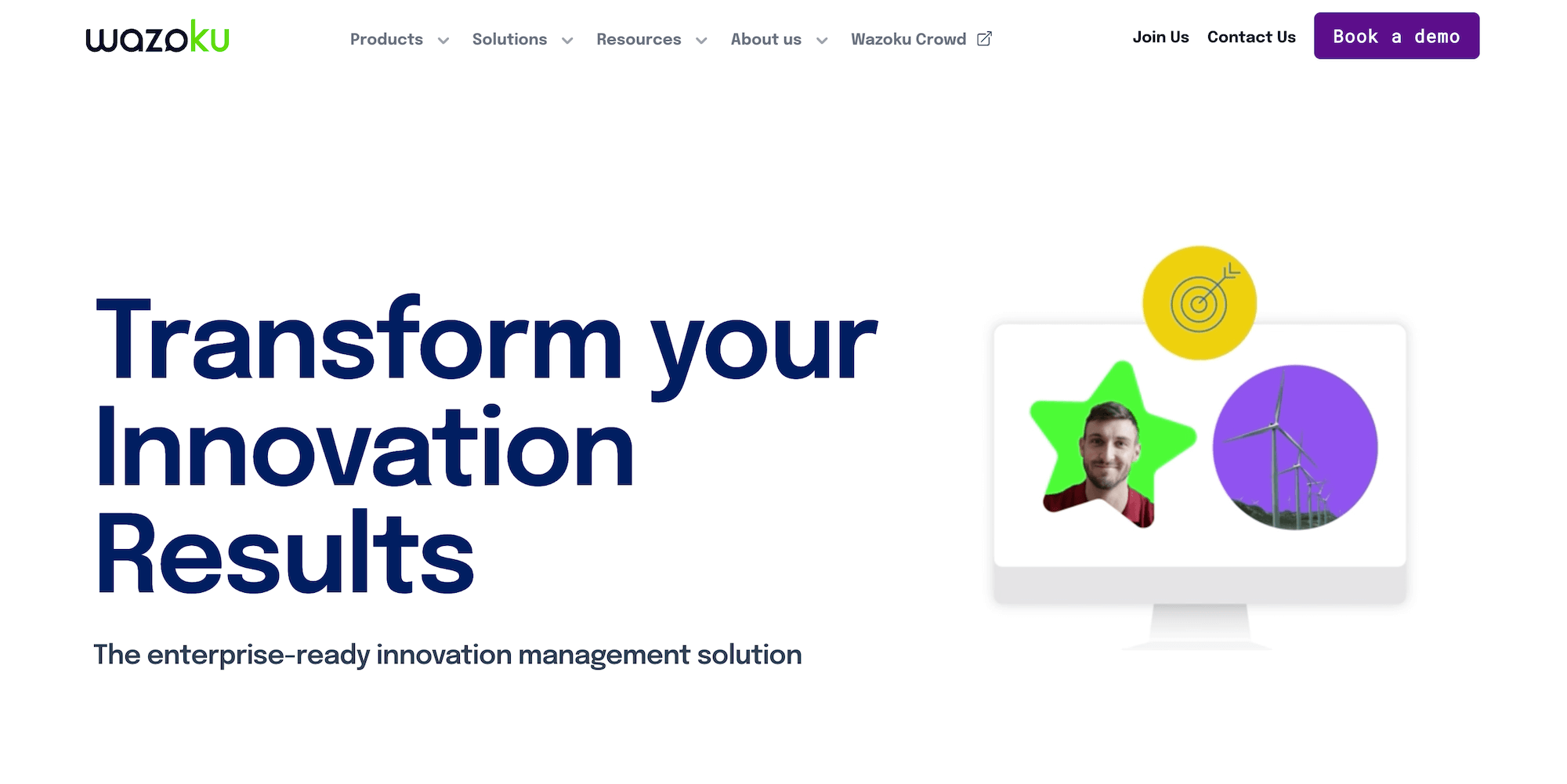
Wazoku is a well-known enterprise innovation management software company that has worked with organizations such as NASA, Mastercard, Microsoft, and Shell.
When it comes to onboarding, Wazoku takes a similar approach to InnovationCast and HYPE Innovation. They’ll meet with you to discuss your business goals and challenges and configure workflows around these requirements.
This ensures that the innovation process fits your organization's specifications perfectly.
Wazoku also does a great job at fostering innovation and collaboration within enterprise companies using features like:
Internal innovation: Where you can create challenges and gather ideas from employees that are relevant to company issues.
Tech scouting: Where you can quickly discover new and disruptive technologies in your industry.
Innovation networks: Where you can connect to other innovation teams and solve complex, worldwide issues.
Pricing
Wazoku does not share pricing on the site; they offer custom quotes on a per-customer basis.
4. Planbox
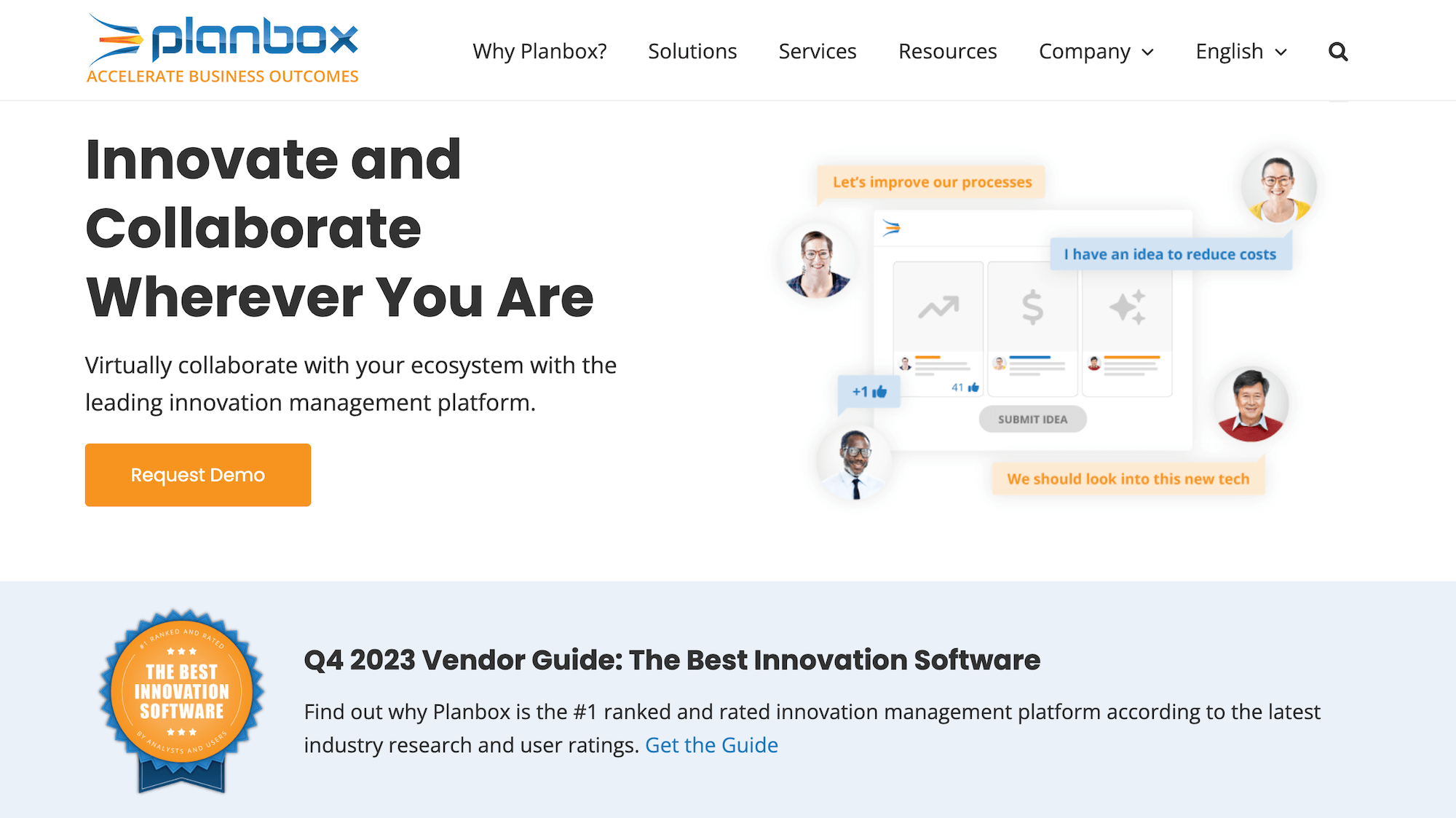
Planbox is another innovation management platform that focuses on fostering collaboration among employees and stakeholders. They achieve this by jumping on a call with you during onboarding to get an idea of your business goals and develop the platform around them.
From here, you can access features that help you collect innovative ideas and feedback from other employees. These features include:
Tech scouting: Where innovation teams track emerging technologies, startups, markets, competitor news, and more.
Corporate venturing: Where innovation teams find investment and partnership opportunities.
Challenge-based innovation: Where stakeholders can prompt employees to submit ideas relevant to company challenges.
Continuous improvement: Where stakeholders can streamline the process to continuously improve existing features, products, and business models.
Pricing
Planbox reportedly charges $2 per user per month, but if you're interested in this solution, we suggest contacting their team to learn more about pricing.
5. Brightidea
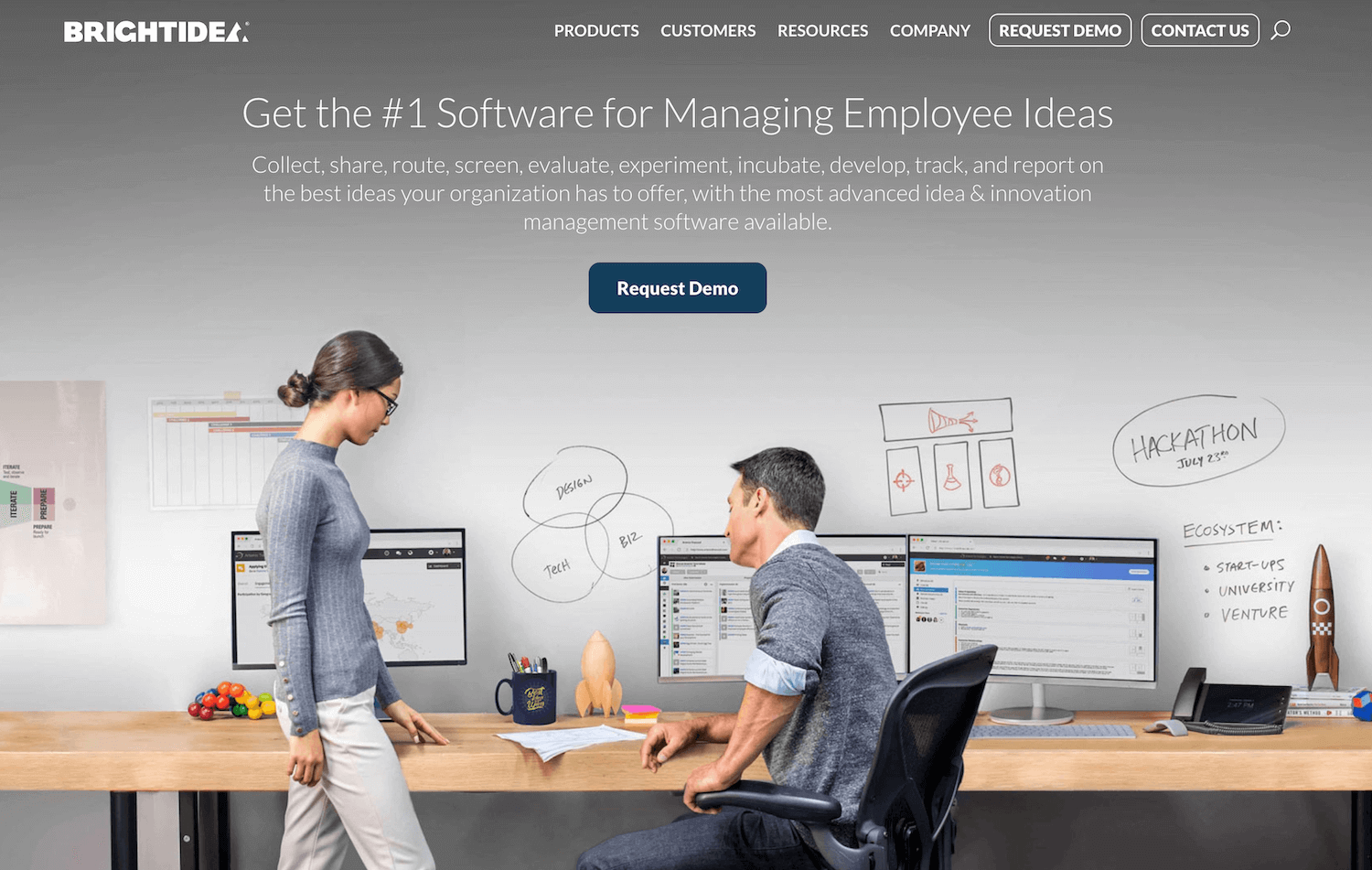
The last enterprise innovation management solution we want to discuss is Brightidea. They have worked with and built successful innovation ecosystem for massive companies like Nike, LinkedIn, Dell, and GE.
Brightidea offers the features you’ll need to collect innovative ideas from employees and move these ideas into implementation by testing and validating them. These features include:
Idea box: Where employees can freely submit ideas, and managers can track these ideas and provide feedback.
Lab: Where innovation managers and stakeholders can assess ideas and decide which to pursue.
Program: Where innovation managers can notify employees about organizational initiatives and prompt them to submit ideas related to these initiatives.
Transformation: Where innovation managers can manage ideas, assign tasks to various teams, and get feedback from subject-matter experts within the company.
Ecosystem: Where stakeholders can connect with outside parties to help with decision-making and improve internal innovation processes.
Like most innovation management software, their team will also meet with you to understand your innovation strategy and design the platform around your goals.
Pricing
Brightidea does not share pricing on their site, but users report the subscription starts at $59 per month.
Read more: 6 Brightidea Competitors and Alternatives [Review Guide]
Build a Culture of Innovation Inside Your Enterprise Company Today!
If you’d like to try InnovationCast, you can schedule a free demo here. Our team will then hop on a call with you to establish idea assessment workflows that push your ideas into implementation.
Related reads:

